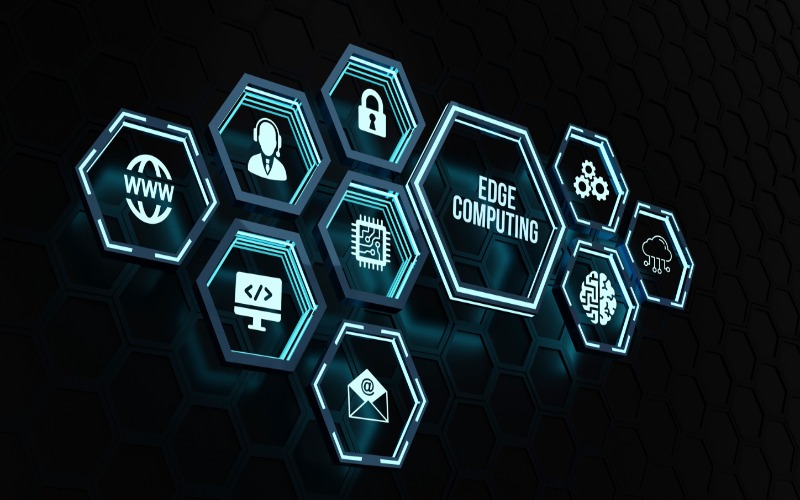Convenience and ease are cornerstones of cloud computing, which is why so many companies rely on these services. Cloud computing also makes data theft exponentially more convenient and easier, as hackers now have access to the stored data of hundreds of millions of customers—directly from their computers. The use of cloud computing by organizations drives up incidents of data theft, compromising the privacy and security of customers, employees, and the organization itself—at a significant cost to businesses. While there is no one-size-fits-all solution for companies, end-to-end encryption and reliance on edge computing are emerging as the best line of defense.
Inherent Data Security Risks in Cloud Computing
Cloud computing—through which information can be processed and stored online instead of on a local computer—traces its origins back several decades. It wasn’t, however, until Amazon Web Services (AWS) debuted its cloud service nearly 20 years ago that the concept gained significant traction as a business solution. Today, more than half of organizations’ data is stored in the cloud—a figure that is expected to reach nearly 70 percent by 2026, according to a recent study by Thales.
While cloud reliance is ubiquitous and powers business operations worldwide, it has a dark side: data theft. According to Thales, 47 percent of data in the cloud is sensitive, making it a prime target for cybercriminals. Before the cloud, thieves had to access the physical location where data was stored. Today, hackers can remotely access the personal data of hundreds of millions of individuals, often operating from jurisdictions beyond legal reach and, in many cases, openly hostile.
That availability has made the incidence of data theft skyrocket in recent years. According to Forbes, there was a 72 percent increase in data breaches worldwide between 2021 and 2023. Globally, just one data breach can cost nearly $5 million. In the United States, however, that cost is almost double.
It is a price tag that organizations are increasingly dealing with. One of the most well-known breaches occurred in 2017 when nearly 150 million Equifax customers had their data exposed through a hack. The company spent over $1 billion on affected users, legal fees, and to upgrade its data security and technology. Two years later, Capital One was hit with an $80 million fine after data from 100 million of its customers was breached. In May 2024, 560 million Ticketmaster customers were victimized by a group of data hackers who accessed the organization’s cloud storage system.
Organizations know how vital cloud security is. Thales found that security investments are the highest priority for business leaders. Hackers, however, can always find new vulnerabilities in the cloud. Given the widespread utilization of the cloud, if thieves can’t compromise one company’s cloud infrastructure, they will move along to another.
How Edge Computing Can Mitigate the Risks of Cloud
To strengthen cybersecurity, some organizations turn to encryption, which creates a unique key known only to the user. It’s a method that can keep data being processed and at rest from being readable by thieves. For instance, Apple’s end-to-end encryption protects data like iCloud messages and iPhone users’ voice memos.
Demand for this type of solution is surging. A study published in Fortune Business Insights found that the cloud encryption market was valued at $3.18 billion last year and is projected to jump to $34.63 billion by 2032.
While encryption can add a layer of defense to offer sustainable protection, it is critical for organizations to encrypt 100 percent of data. Edge computing is the solution for companies seeking leading-edge cybersecurity. This approach processes and stores data closer to local devices, as opposed to in the shared cloud, and offers three primary benefits:
- Security. Edge computing keeps data closer to its source with a decentralized approach that offers inherently stronger security bolstered by encryption.
- Privacy. As cybersecurity challenges become more mainstream, consumers are increasingly concerned about their data privacy. Security camera company Eufy, for instance, stores customer video data locally, which is decrypted on the end user’s device only on demand, as opposed to competitors that store all the videos in the cloud and have full access to unencrypted video footage.
- Speed. When data is processed closer to the source, it reduces bandwidth, which enables applications to run more quickly and efficiently. Data processed on the edge device also leads to reduced latency because the processing is done directly on the device instead of needing an extra hop to frequently overloaded web servers. Many edge computing solutions also store a local copy on the edge client, with the added benefit of offline access and more resilience to cloud infrastructure outages.
Why Edge Computing Is the Future
The advent of artificial intelligence (AI) and large language models (LLMs) is paving the way for edge computing to become more accessible to enterprises. LLMs can simplify the code it takes to create edge computing solutions from thousands of lines down to just one. This reduced codebase will be easier to deploy and manage at the edge. That will lead to a proliferation in the edge computing market and an upswing in the prevalence of organizations relying on edge computing. Meanwhile, with cyberattacks and economic uncertainty cited as leading concerns for CFOs, organizations will feel the urgency to turn to a more feasible and stable security model. Cyber liability insurance is getting more expensive. Soon, with the increase in the adoption of edge computing, hackers will concentrate their attacks on companies that do not use edge computing. This increased risk could make insurance even more expensive for those who do not migrate to edge computing.
According to a recent study by the International Data Corporation, global investment in edge computing is expected to jump 15 percent yearly by the end of 2024 to $232 billion. The organization says that figure could reach $350 billion in just three years.
IDC Research Vice President Dave McCarthy accurately predicted that edge computing will “play a pivotal role in the deployment of AI applications.” It’s a trend that’s already in motion. Tech titan Apple, for instance, recently released its Apple Intelligence platform, leveraging AI and edge computing.
Embrace Transformation Today
While cloud computing has become commonplace, the vulnerabilities it exposes organizations to can have lasting impacts. Given today’s economic uncertainty, this is a risk that companies can’t afford to take. Edge computing is the answer—and it’s one that leading businesses are already embracing. Now is the time for companies to evaluate their security risks, consider the role edge computing could play in closing those gaps, and create a long-term strategy for protecting the data and business.











